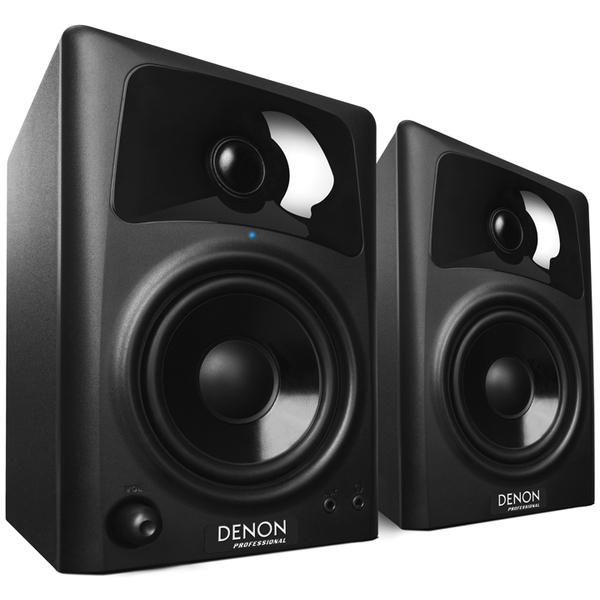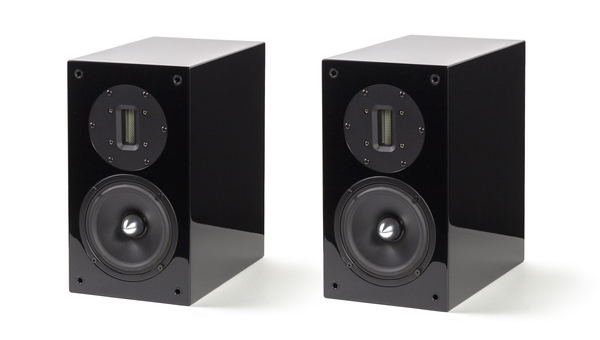Production of speaker cases: Overview of materials

Professional active acoustics Denon DN-304S
Previously, the speakers were ordinary horn loudspeakers and did not have a body as such. Everything changed when, in the 1920s, speakers with paper diffusers appeared.
')
Manufacturers began to produce large enclosures that contain all the electronics. However, up until the 1950s, many audio equipment manufacturers did not completely close the speaker enclosures - the back end remained open. This was due to the need to cool the electronic components of the time (lamp equipment).
The task of the speaker enclosure is to control the acoustic environment and hold the speakers and other system components. Even then, it was noted that the body can have a serious impact on the sound of the loudspeaker. Since the front and rear parts of the speaker emit sound with different phases, there was an amplifying or weakening interference, which led to a deterioration of the sound and the appearance of a comb filtering effect.
In this regard, began the search for ways to improve the sound quality. To do this, many began to explore the natural acoustic properties of various materials suitable for the manufacture of shells.
Waves reflected from the inner surface of the walls of the column housing are superimposed on the main signal and create distortions, the intensity of which depends on the density of the materials used. In this regard, it often turns out that the case is much more expensive than the components enclosed in it.
During the production of cases in large factories, all decisions regarding the choice of the shape and thickness of materials are made on the basis of calculations and tests, however, Yuri Fomin, a sound engineer and engineer of acoustic systems, whose development underlies the multimedia systems under the brands Defender, Jetbalance and Arslab, is not excludes that even in the absence of special musical knowledge and extensive experience in the audio industry, you can do something close in characteristics to “serious” Hi-Fi.
“We need to take ready-made designs that engineers share on the network, and repeat them. This is a 90% success rate, ” notes Yuri Fomin.
When creating the speaker case, it should be remembered that, ideally, the sound should come only from the speakers and special technological openings in the case (phase inverter, transmission line) - you need to take care that it does not penetrate through the walls of the speakers. To this end, it is recommended to make them from dense materials with a high level of internal sound absorption. Here are a few examples of what you can build a case for the speakers.
Chipboard
These are boards made of compressed wood chips and glue. The material has a smooth surface and loose loose core. Chipboard well dampens vibration, but passes through the sound. Plates are easily bonded with wood glue or mounting glue, but their edges tend to crumble, which makes working with the material a little harder. He is also afraid of moisture - in case of violation of production processes, it easily absorbs and swells.
The stores sell boards of different thickness: 10, 12, 16, 19, 22 mm and so on. For smaller enclosures (less than 10 liters in volume), a 16 mm thick chipboard is suitable, and for larger enclosures, 19 mm thick boards should be chosen. Chipboard can be lined: pasted film or cloth, putty and paint.
Chipboard is used to create a Denon DN-304S speaker system (pictured above). The manufacturer chose the chipboard because this material is acoustically inert: the speakers do not resonate and do not color the sound even at high volume.
Lined Chipboard
This is a chipboard lined with decorative plastics or veneer on one or both sides. Plates with wood veneer are sealed with ordinary wood glue, but for chipboard, lined with plastic, you have to buy a special glue. You can use edgeband to cut the board.
Carpentry
Popular building material from battens, bars, or other fillers that are veneered or veneered on both sides. The advantages of the carpentry board: relatively low weight and ease of processing edges.
Oriented strand board (OSB)
OSB are boards pressed from several layers of thin plywood and glue, the pattern on the surface of which resembles a mosaic of yellow and brown colors. The surface of the material itself is uneven, but it can be sanded and varnished, since the texture of the wood gives this material an unusual look. This stove has a high sound absorption coefficient and is resistant to vibrations.
It is also worth noting that due to its properties, the PCB is used to form acoustic screens . Screens are needed to create listening rooms where users can appreciate the sound of speakers in near-perfect conditions. Strips of OSB are mounted at a certain distance from each other, thereby forming a Schröder panel. The essence of the solution lies in the fact that the band fixed at certain points under the influence of an acoustic wave of the calculated length begins to radiate in antiphase and dampens it.
Medium Density Fiberboard (MDF)
Made from wood shavings and glue, this material is smoother than OSB. Due to its structure, MDF is well suited for the manufacture of designer cases, as it is easy to cut, this simplifies the joining of parts fastened together with the help of mounting glue.
MDF can be veneered, putty and paint. The thickness of the plates varies from 10 to 22 mm: for column housings with a volume of up to 3 liters there will be enough boards with a thickness of 10 mm, up to 10 liters - 16 mm. For large enclosures, it is better to choose 19 mm.
If, when choosing a material for the manufacture of speaker enclosures, the sound aspects are discarded, then there will remain three decisive parameters: low cost, ease of processing, and ease of gluing. MDF just has all three. It is the low cost and “ductility” of MDF that make it one of the most popular materials for the manufacture of speakers.

An example of using MDF is the Arslab Classic 1 SE bookshelf speakers, whose enclosure walls are made of thick fiberboard that prevent vibrations and sound staining.
Plywood
This material is made of compressed and glued thin veneer (about 1 mm). To increase the strength of plywood, the veneer layers are superimposed so that the fibers of the wood are directed perpendicular to the fibers of the previous sheet. Plywood is the best material to suppress vibrations and keep sound inside the case. You can glue plywood boards together with ordinary glue on wood.
Sanding plywood is more difficult than MDF, so you need to cut out the parts as accurately as possible. Among the advantages of plywood is its ease. For this reason, cases of musical instruments are often made of it, because it is rather offensive to cancel the concert due to the fact that the musician has torn back.
This material is used by Penaudio for the production of floor acoustics - it uses Latvian plywood, which is made of birch. Many people like the look of treated birch plywood, especially after varnishing, - this makes the case unique. This is what the company uses: the transverse layers of plywood have become a kind of "calling card" of Penaudio.

Outdoor speakers Penaudio Rebel Three
A rock
The most commonly used marble, granite and slate. Slate is the most suitable material for the manufacture of shells: it is rather simple to work with it because of its structure, and it effectively absorbs vibrations. The main disadvantage is that special tools and stone processing skills are needed. In order to somehow simplify the work, it may make sense to make only the front panel of a stone.
It is worth noting that to install columns of stone on the shelf, you may need a mini-crane, and the shelves themselves must be strong enough: the weight of the stone audio speaker reaches 54 kg (for comparison, an OSB column weighs about 6 kilograms). Such cases seriously improve the sound quality, but their cost may be "very heavy".
Columns from a single piece of stone are made by the guys from the company Audiomasons. Shells are cut from limestone and weigh about 18 kilograms. According to the developers, the sound of their product will appeal to even the most sophisticated music fans.
Plexiglas / glass
You can make the case for the speakers of a transparent material - this is really cool when you can see the "insides" of the column. Only here it is important to remember that without proper isolation, the sound will be terrible. On the other hand, if you add a layer of sound-absorbing material, the transparent body will no longer be transparent.
A good example of acoustic hi-end equipment made of glass is the Crystal Cable Arabesque. Cases of Crystal Cable equipment are made in Germany from 19 mm thick glass strips with ground edges. The parts are fastened together with an invisible glue in a vacuum unit in order to avoid the appearance of air bubbles.
At CES-2010, held in Las Vegas, the updated Arabesque won all three Innovation awards. “Until now, no equipment manufacturer has been able to achieve true hi-end sound from acoustics made from such a complex material. - wrote critics. “Crystal Cable has proven this to be possible.”
Laminated wood / wood
Good cases are made of wood, but here an important point needs to be taken into account: the tree has a tendency to “breathe”, that is, it expands if the air is wet and shrinks if the air is dry.
Since the wooden block is glued on all sides, tension is created in it, which can lead to cracking of the wood. In this case, the body will lose its acoustic properties.
Metal
Most often aluminum is used for these purposes, more precisely, its alloys. They are light and hard. According to some experts, aluminum can reduce the resonance and improve the transmission of high frequencies of the sound spectrum. All these qualities contribute to the growth of interest in aluminum from the manufacturers of audio equipment, and it is used for the manufacture of all-weather acoustic systems.
There is an opinion that making an all-metal body is not a good idea. However, it is worth trying to make the upper and lower panels of aluminum, as well as the stiffness walls.
Our materials on the topic:
- Section "Do it yourself": Components and manuals
- Development of acoustics: what sound engineers do and whether it is possible to create acoustics with your own hands
- How Arslab acoustics are created and why High-End can be sold at the price of Hi-Fi
- Old new sound: The views of the engineer and music lover
Source: https://habr.com/ru/post/394751/
All Articles